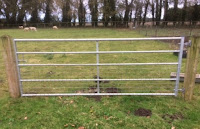Some years ago when I first took on an allotment most of the long rectangular plots on the site were cultivated in a traditional way with straight rows and relatively wide planting distances. The crops were, by and large, annually confined to the common staples characteristic of a traditional British diet: "Florence fennel? What the bloody 'ell is that when it's at home?"
But the allotmenteers knew how to maintain a productive plot and grow admirable vegetables, some of which featured in the annual village horticultural show. They were doing exactly what their fathers had done before them. The men (they were nearly all men) had names like Alf, Reg, Bert and Ron. Some of them even rode to their plots on an emblematic heavy black bicycle. One or two wore a jacket and tie as they worked their plot, Percy Thrower style. Even if in reality they weren't all elderly, they seemed it. They were, however, generally welcoming at the appearance of a youthful new plot holder, but I suspect at the same time they were wondering how long I, with my white collar hands, would stick at it.
But the allotmenteers knew how to maintain a productive plot and grow admirable vegetables, some of which featured in the annual village horticultural show. They were doing exactly what their fathers had done before them. The men (they were nearly all men) had names like Alf, Reg, Bert and Ron. Some of them even rode to their plots on an emblematic heavy black bicycle. One or two wore a jacket and tie as they worked their plot, Percy Thrower style. Even if in reality they weren't all elderly, they seemed it. They were, however, generally welcoming at the appearance of a youthful new plot holder, but I suspect at the same time they were wondering how long I, with my white collar hands, would stick at it.
 |
| Percy Thrower, at one time probably the most well known gardener in Britain |
At this time my vegetable growing interests were enthused by a TV series 'All Muck and Magic' which attempted to disseminate ideas around an organic approach to gardening. Some of the programme presenters went on to take senior roles with the Henry Doubleday Research Association (HDRA), first set up by an early advocate of organic gardening Lawrence Hills, and which is now known as Garden Organic. They have demonstration organic gardens at Ryton near Coventry which are definitely worth a visit. Another of the presenters, Sue Stickland, has a regular column in Home Farmer magazine where she shares her wealth of practical experience as former head gardener at Ryton Gardens.
I got to know about the value of copious compost, deep bed gardening, no dig approaches, making use of weed suppressing cardboard and old carpets, block planting, non-chemical approaches to pest control, using raised beds and lots more. These ideas all influenced my early vegetable growing practices.
Latterly, however, I've tended to revert in some ways to more traditional practices (without the chemicals needless to say). More 'allotment style'. I like to space my onions, for example, so that I can hoe between them. Straight rows I find are easier to keep weeded so I need space between the rows, although I keep this as narrow as my current state of nimbleness allows. I put large amounts of manure and compost into my sandy soil but I don't have enough to provide the minimum 2" mulch over the whole of my two allotment sized plots. In recent years there has been a fashion for petite vegetables which favours extra close planting but I'm happy with a normal sized cauliflower and give them the space they deserve. Many organic gardening principles I still adhere to, of course. One thing I've dispensed with, though, is raised beds.
Raised beds are an approach which nowadays is almost presented as the default approach to vegetable growing, not just in lifestyle magazines and TV programmes, but some gardening magazines too. I don't believe that they are always the best approach. Some soils can dry out quickly in a raised bed. Constructing the edging for raised beds can be expensive. It might also involve having to buy in additional top soil to raise the bed. They can also be a bit restrictive in growing space particularly for those crops, such as potatoes and brassicas, that need a lot of room. They can be potentially limiting for those aiming for self-sufficiency.
However, in particular conditions and circumstances raised beds can be of undoubted value. At the risk of contradicting myself, here are some of the reasons where I think raised beds are a good idea:-
- Where the soil is thin or stoney, perhaps in areas of rocky terrain.
- Where the soil is especially heavy and prone to water logging.
- Where only a small area for growing is available and intensive use of space required.
- Where time is limited as raised beds can reduce the amount of weeding and watering required and are generally easier to manage. When I was professionally at my busiest and the children were younger I gave up the allotment and used raised beds in the garden for this very reason. I could get a lot done with a raised bed in 30 minutes at the end of a long day at work.
To be fair these conditions are quite commonly encountered, but if you have the space and decent enough soil I don't see any reason for thinking raised beds are the automatic choice for growing vegetables successfully. Ultimately, though, it is down to preference and whatever approach works best for you. But my vegetable plots these days will probably not raise any eyebrows with Alf, Reg, Bert and Ron.

















